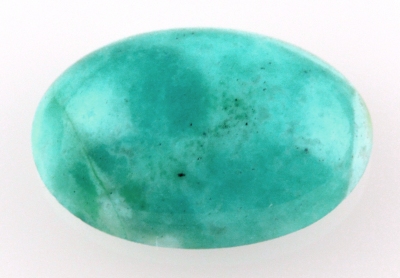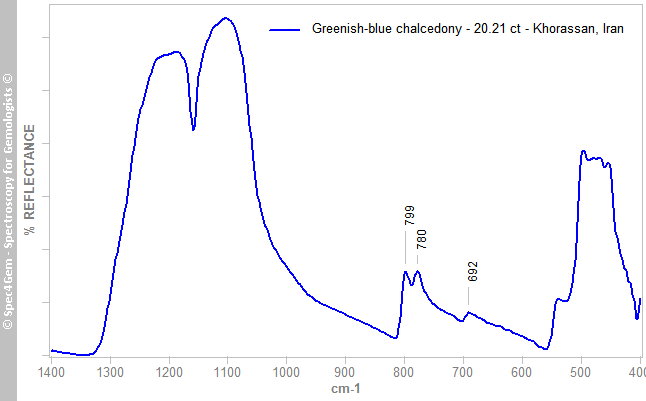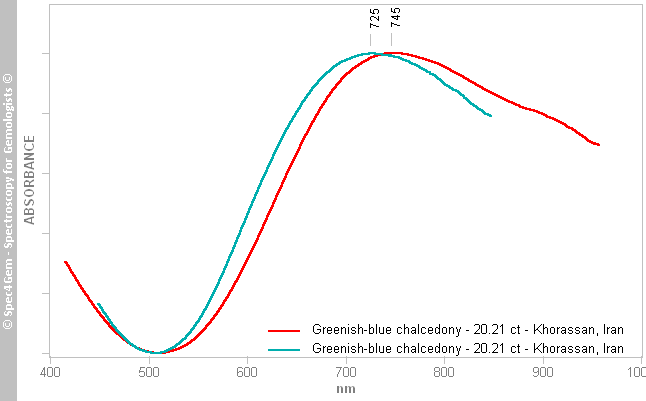Greenish-blue chalcedony, a "gem silica" from Khorassan, Iran
- Details
- Created: Sunday, 27 November 2016 10:58
The cab material described here is a new discovery from Khorassan province, Iran. The province is located next to the north-eastern border (Khorassan means "where the sun arrives from").
The material shows a beautiful greenish-blue color similar to that of some chrysocolla and chalcedony especially that of the gem silica. Such material has already been mined in Iran as reported in 2007[8].
Gem silica is the trade name for a rare gemstone with a vivid bluish-green to greenish-blue hue. Also known as "gem silica chrysocolla", "chrysocolla chalcedony", it is actually a member of the chalcedony family and not, strictly speaking, a variety of chrysocolla at all. Despite that, such a chalcedony variety gets its color from its chrysocolla inclusions and it is thus indirectly colored by copper.
Gemmes.fr is thanked for donating the cabochon shown in figure 1.
 Figure 1. The 20.21 ct cab showing an uneven greenish-blue color
Figure 1. The 20.21 ct cab showing an uneven greenish-blue colorwith some spotty green and black inclusions.
| Shape | oval cab |
| Size | 24.5 x 17.0 x 7.4 mm |
| Color | greenish-blue ranging from light-grayish greenish-blue to medium greenish-blue |
| Lustre / Diaphaneity | sub-vitreous / almost opaque |
| Weight | 20.21 ct |
| SG | 2.62 |
| RI | ? |
| DR | - |
| Pleochroism | - |
| Polariscope / Conoscope | stays light through 360° -> polycrystalline |
| SWUV | inert |
| LWUV | inert |
| Magnetic susceptibility | < 0 (slightly diamagnetic) |
Table 1. Observational and measured properties
The cab, even if well polished, shows uneven polishing quality with reflected light as if the quality of the material changed in some area. This is also confirmed with the fingers while "stroking" the cab. Such observations are usually observed on materials showing some altered area with a different hardness. It should not be mixed up with what can be observed in the stabilized/filled materials (turquoise, etc.). It was impossible to read RI even with the spot-reading method nor with a reflectivity meter that gave a result below 1.43.
The fracture on the cab's left was naturally "repaired" by a green mineral filling (likely a copper mineral).
Infrared reflectance spectroscopy:
The IR reflectance spectrum was acquired from the table. The spectrum (figure 2) is characteristic of quartz material, this is consistent with chalcedony (a cryptocrytalline / polycrystalline quartz).
 Figure 2. The IR reflectance spectrum of the 20.21 ct greenish-blue cab is a characteristic spectrum of quartz.
Figure 2. The IR reflectance spectrum of the 20.21 ct greenish-blue cab is a characteristic spectrum of quartz.UV-VIS-NIR spectroscopy:
The UV-Vis-NIR spectrum was acquired with the light path crossing from the top to the back, anyway since the material is polycrytalline, the orientation does not affect the absorption / transmission spectrum. However because of the uneven color of the cab material that vary from a light grayish greenish-blue to a dark greenish-blue, the spectrum can be modified depending on the light path position. Two spectra were acquired from the left hand side of the cab as represented figure 1, the acquiring spots were shifted of about 5 to 7 mm from each other. Both spectra show minimal absorption around 510 nm and a maximum absorption near 725 nm for the darker greenish-blue (figure 2, green-blue spectrum) and 745 nm for the grayish greenish-blue (figure 2, red spectrum). Apart these small discrepancies, the two spectra have a similar pattern. The transmission window between 450 nm and 550 nm explains the observed color of the gemstone.
 Figure 3. UV-Vis spectrum of the bluish-green rough showing nm, usually attributed to Cu2+ [1][2][9][10].
Figure 3. UV-Vis spectrum of the bluish-green rough showing nm, usually attributed to Cu2+ [1][2][9][10].The main absorption at 725-745 nm is usually attributed to Cu2+ in chalcedony[1][2][9][10], especially to chrysocolla that exists as microscopic inclusions within chalcedony material. Even if chrysocolla is common within chalcedony, the UV-Vis spectra are not sufficient to confirm the presence of that chrysocolla, they just reveal that the absorption pattern is similar to that of other chalcedonies with chrysocolla, therefore and unless contradictory example, it is possible to assume that this new material is colored by divalent copper, likely by chrysocolla.
Photoluminescence spectroscopy:
No luminescence observed with the following sources : 254, 280, 365 and 405 nm.
Conclusion:
Classical gemology results and IR reflectance spectroscopy confirmed that the greenish-blue material of the cab is chalcedony (polycrystalline quartz) and UV-Vis spectroscopy pointed out it is colored by Cu2+, most likely by chrysocolla, a Cu2+ bearing material. According to the latest definitions of the gem silica, this cabochon can be qualified "gem silica" .
[1] Mineralogical Applications of Crystal Field Theory, R. G. Burns, 2005, ISBN: 0521017858 | 978-0521017855 pp. 235–239 - Andersen (1978)
[2] Natural-Colored Chrome Chalcedony Identified Using Laser Ablation–Inductively Coupled Plasma–Mass Spectrometry (LA-ICP-MS). Andy Shen, GIA Laboratory, Carlsbad
[3] Nathan Renfro, GIA, Carlsbad. A new natural-color bluish green chalcedony. Gems & Gemmology, 2015, Winter, pp. 452–454.
[4] Blue Chrysocolla Chalcedony from Peru. Journal of Gemmology, 2014, volume 34, No.1, pp. 9–10
[5] Chrysocolla Chalcedony from Spain. Journal of Gemmology, 2015, volume 34, No.6, p. 472
[6] Chrysocolla chalcedony from Acari, Peru. Gems & Gemmology, 2010, Summer, pp. 148–149.
[7] Dyed chalcedony resembling chrysocolla. Gems & Gemmology, 2008, Winter, p. 379.
[8] Chrysocolla chalcedony from Iran/Armenia area. Gems & Gemmology, 2007, Winter, pp. 376–377.
[9] Dyed blue chalcedony detected by UV-Vis-NIR spectroscopy. Gems & Gemmology, 2007, Fall, pp. 245–246.
[10] Identification of Dyed Chrysocolla Chalcedony. Gems & Gemmology, 2006, Fall, p. 140.
[11] Pink opal from Monte Rosa, Peru. Gems & Gemmology, 2006, Summer, pp. 176–177.
[12] Adularescent chalcedony from Iran. Gems & Gemmology, 2004, Winter, p. 337.
[13] Chrysocolla-colored chalcedony from Mexico. Gems & Gemmology, 1992, Spring, pp. 59–60.

